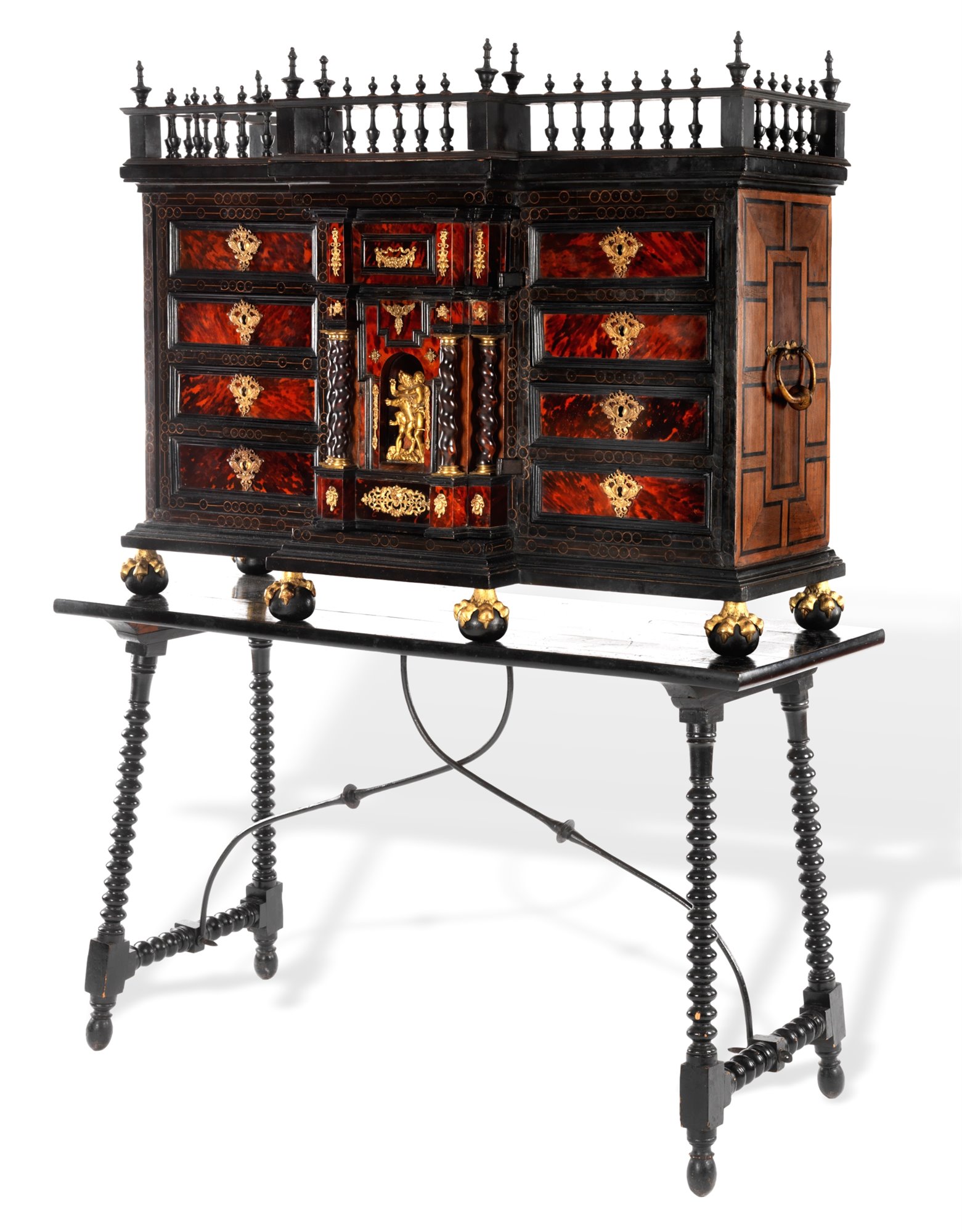Prestigioso stipo monetiere in legno ebanizzato, tartaruga ed inserti in bronzo
Ebanista fiammingo del Seicento
Prestigious coin cabinet in ebonized wood, veneered in tortoiseshell and decorated with applications in gilded bronze;
Eight front drawers with central temple door enriched by twisted columns, complete with ebonized wood table with turned legs and joined by metal crosspieces.
Flanders, 17th century
Measurements: coin cabinet h.78 x 124 x 44 cm.
complete with the table h.179 x 136 x 49 cm.
PROVENIENZA: HAMPEL 3 dicembre 2020
https://www.hampel-auctions.com/a/Antwerpener-Schildpattkabinett.html?a=125&s=724&id=562965&....
Eight front drawers with central temple door enriched by twisted columns, complete with ebonized wood table with turned legs and joined by metal crosspieces.
Flanders, 17th century
Measurements: coin cabinet h.78 x 124 x 44 cm.
complete with the table h.179 x 136 x 49 cm.
PROVENIENZA: HAMPEL 3 dicembre 2020
https://www.hampel-auctions.com/a/Antwerpener-Schildpattkabinett.html?a=125&s=724&id=562965&....
We embellish the collection of works in our gallery with this rare example of coin cabinet, made by a Flemish master cabinetmaker of the seventeenth century.
It is a furniture of extreme refinement and elegance, expertly structured in ebonized wood, rosewood, tortoiseshell inserts, with applications and sculptures in gilded and chiseled bronze. The structure of this precious furniture is in walnut wood.
The use of architectural models for the cabinets dates back to the sixteenth century and for more than two centuries enjoyed great favor in all European courts. Many are those who since the seventeenth century use the tortoise as the main coating of the surfaces, alternating from time to time with the precious exotic essences such as ebony and rosewood, golden metals.
However, its use as a valuable coating re-emerged from the 17th century, mainly in the German production centers, Augusta of Bavaria and Antwerp in Flanders, where it was used for the lining of precious jewelry caskets and used as a coating for small furnishings, just like the coin holders.
The high price and consequent prestige of tortoiseshell furniture are explained by the scarcity of the material already at the time, which was essential to import (usually from Central America) and which, for its work, required highly specialized labor.
Also in Italy, especially in the southern part and in the Kingdom of Naples and in Milan in particular, the production of artistic artefacts in tortoiseshell is linked to the presence and influence of Nordic cabinetmakers and the continuous trade with the rest of Europe.
Focusing again on our furniture, one cannot but be struck by the exceptional design which, in full respect of the Baroque characters, follows a sumptuous architectural form, with the front projecting in the center, marked by four drawers on each side, which frame a door in the shape of a temple supported by 4 columns.
In the central portion of the door an exceptional temple architecture is proposed, supported by four spiral columns called Solomonic and bronze capitals with a niche embellished with a gilded bronze sculpture depicting the first of the twelve labors of Hercules, with the hero defeating the Nemean Lion.
The door on the front then gives access to an internal compartment, entirely finished and inlaid with the same spherical inlays that we find on the outside, and with various drawers of different sizes and an ancient central.
The drawers on the sides are highlighted by the shields on the locks, made of gilded bronze
The decoration of the sides is reduced to rhombuses made in inlay using fillets set in dark on light wood, an element that is repeated inside the chapel: the lid has this elegant geometric decoration, and so do the drawers it uncovers.
The hardware of the opening hinge is original.
The legs of the furniture have been carved in the shape of a bird's claw resting on a sphere, a typical habit of the 17th century.
The supporting table is in ebonized wood, with four turned legs joined by metal crosspieces.
Excellent storage conditions.

